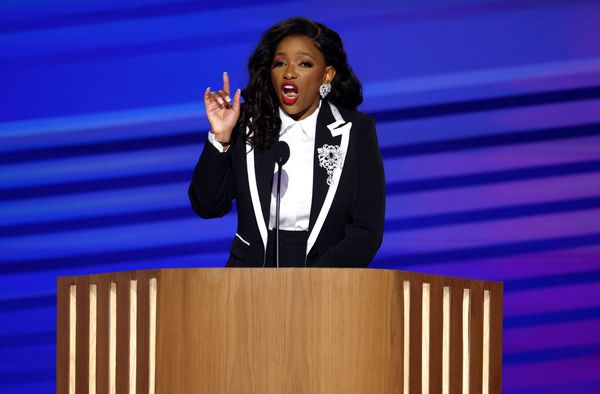
When the presenter Jesse Burgess goes to a restaurant, the kitchen always sends him dishes he didn’t order. One of the ironies of fame is that the more you can afford, the less you have to pay for it. Except that Burgess isn’t a celebrity, he says. “I’m just a guy who really likes food.”
Burgess is the 34-year-old host of Topjaw, a small but mighty internet platform featuring chefs and foodies, whose “Best of” series, for better or worse, has changed the way Londoners – and those beyond – eat out. The Topjaw channel has been around since 2015 but Burgess started the viral series in 2023 with his friend Will Warr, who is also Prince and Princess of Wales’s videographer (he made Kate’s cancer statement video). It has now grown to more than a million followers.
The series’ premise is simple. In a snappy 90 seconds, Burgess asks influential food industry types for their favourite places to eat, drink or get drunk. Having featured a mix of influential chefs, critics and celebrities including Gordon Ramsay, Andrew Garfield and Florence Pugh, the quick-fire formula – best coffee in London? Best Sunday lunch? Best burger? – shares some DNA with the “man on the street” interview, in which someone holding a microphone stops people to ask them about their relationship, or their outfit.
Beyond his Instagram followers, Burgess is an unknown entity. But if you’re a chef who has appeared on his show or seen your restaurant recommended on it? “It’s a hugely important platform,” says Oisín Rogers, who owns the Devonshire, a central London pub famed for its food and Guinness, and who has appeared on Topjaw several times.
With his Rembrandt curls, square jaw and wry sense of humour, Burgess’s appeal is obvious, and the content he makes is informative and wholesome. It’s been so successful that Burgess and Warr have taken the format beyond London, to Cornwall, Paris and New York, while Burgess has started fronting a new behind-the-pass TV series, Knife Edge: Chasing Michelin Stars, on Apple TV.
But Topjaw has also become something of a target for some who find its format infantilising. One restaurant industry insider said: “It’s lowest common denominator content, which is the stuff that absolutely slaps but what else does it do?” Another describes it as: “One dimensional but highly addictive.” As culture becomes increasingly atomised online, they argue, it’s predicated on “chasing the zeitgeist”, which has the effect of creating hype where perhaps there isn’t any, a phenomenon that the writer Gabrielle Bluestone describes as “Schrödinger’s catfish” in her book Hype.
“Does Topjaw drive customers? Certainly,” says Rogers. “You know if someone’s come because of Giles Coren or Grace Dent or Topjaw because they’ll often tell you.”
“It’s not just hype though,” he adds. “There is an element of zeitgeist but asking people who are influential or good at restaurants is just a simple idea: it’s about weaponising opinion. [Topjaw has] no skin in the game so when you trust the person recommending it, and you do when it’s from the horse’s mouth, that information is invaluable.”
At a time when choosing where to eat out can feel overwhelming, the power of influencers grows ever stronger. In spring, the government introduced a new law banning “fake reviews” or “concealed incentives” aimed at influencers (and other beneficiaries) attempting to conceal or omit if they’ve been paid to promote something. Just as restaurant critics usually pay for the meal they critique, Burgess says he and Topjaw “never have and never will be paid by any restaurant we feature or speak about so as to not skew the authenticity of our recommendations”. That said, he also thinks consumers have reached a point where even though they are wise to paid content, they don’t care.
“People may respect my opinion, but I’m not a critic, and really I’m not there to criticise,” Burgess says. Rather he is one of a new breed of gatekeepers through which people in the know can impart the sort of approval that can make or break a place.“Restaurant critics are a different channel,” says Rogers. “They are incredibly important, and they set the base for what people look for in restaurants. But you just need to look at the reach of a [Topjaw] clip to see how influential it is.”
Indeed the Topjaw effect is tangible. Restaurants such as Akub, Kudu, the Seed Library and Fonda are among those that say they have experienced noticeable demand after appearing in videos. According to one restaurant PR, a positive review on Topjaw can bring several hundred new bookings.
On the other hand, one of the most popular questions is the most overrated spot, of which Mayfair’s Sexy Fish, the former tick-box It restaurant with an onyx exterior and a carb-lite menu, is one of the most namechecked. “It seems to represent a group of restaurants where diners are there to ‘be seen’ rather than for the food offering,” Burgess says. “Londoners have a general disdain for that type of establishment.”
The Guardian approached Sexy Fish for comment.
Surely the only real beneficiary of Topjaw’s screengrab content is consumerism? Rogers disagrees: “Asking where to get a decent pint? That’s just a really good, simple question.”
Jesse Burgess’s top London picks
Best restaurant: Camille in Borough.
Best coffee: Bar Italia.
Best pub: I bounce enthusiastically between the George in Fitzrovia and the Coach & Horses in Soho.
Place I’d travel for: Janda Diner in Peckham.
Best of all time: Ynyshir in Wales. Chef Gareth Ward gave me the best meal of my life.







